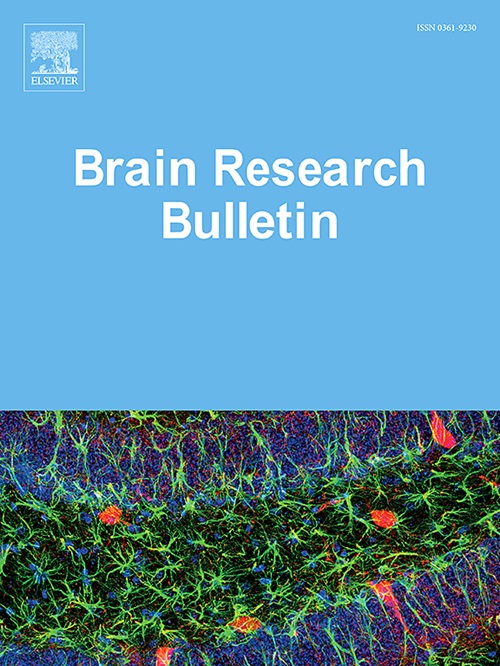小鼠发育和成熟前脑中 GPER/GPR30 报告表达的空间和时间模式
IF 3.5
3区 医学
Q2 NEUROSCIENCES
引用次数: 0
摘要
有证据表明,雌激素在神经发育和功能调节中起着至关重要的作用,G蛋白偶联雌激素受体(GPER/GPR30)似乎是大脑中主要的雌激素受体。然而,GPER在发育和成熟大脑中的分布和功能尚不完全清楚。本研究旨在利用GPER基因报告小鼠,结合荧光原位杂交(FISH/RNAscope)和免疫组化(IHC)技术,表征GPER基因在前脑中的表达。通过将Gper-cre小鼠与Ai14(RCL-tdT)-D或R26-ZsGreen小鼠杂交,构建了两系Gper报告基因小鼠,其在成人脑内的空间分布相同。在前脑,神经元、原生质星形胶质细胞、壁细胞和第三脑室室管膜细胞均表达Gper报告蛋白。表达gper的神经元尤其富集于嗅觉系统和突出网络,包括皮质杏仁核后内侧核(PmCo)、内嗅皮质、岛叶皮质、前额皮质和海马齿状回。RNAscope和神经示踪显示表达gper的皮质神经元为远端兴奋性锥体神经元。表达gper的星形胶质细胞占星形胶质细胞的一小部分(<10 %),并且被发现与神经血管单位密切相关。表达gper的壁细胞没有被常见的周细胞标记物PDGFRβ标记。在神经发育的关键时期(P1-P10), GPER的表达似乎与嗅觉系统和显著性网络中的神经发生、增殖和迁移密切相关。综上所述,GPER/GPR30在前脑中的表达时空格局暗示其可能在调节嗅觉系统、显著性网络和脑血管的发育和功能方面发挥重要作用。本文章由计算机程序翻译,如有差异,请以英文原文为准。
The spatial and temporal pattern of GPER/GPR30 reporter expression in the developing and mature forebrain of mice
Evidence suggest that estrogens play crucial roles in the regulation of neural development and function and the G protein-coupled estrogen receptor (GPER/GPR30) appears to be the predominant estrogen receptor in the brain. However, the distribution and functions of GPER in the developing and mature brain are not fully understood. The current study aimed to characterize the expression of GPER in the forebrain, using Gper gene reporter mice combined with fluorescent in situ hybridization (FISH/RNAscope) and immunohistochemistry (IHC). Two lines of Gper reporter mice were constructed by crossing the Gper-cre mice with Ai14(RCL-tdT)-D or R26-ZsGreen mice, which showed identical spatial distributions of the reporters in adult brain. In the forebrain, neurons, protoplasmic astrocytes, mural cells and ependymal cells of third ventricle, were found to express Gper reporters. GPER-expressing neurons were particularly enriched in the olfactory system and the salience network, including posteromedial nucleus of the cortical amygdala (PmCo), entorhinal cortex, insula cortex, prefrontal cortex and dentate gyrus of the hippocampus. RNAscope and neural tracing showed GPER-expressing cortical neurons were long-range excitatory pyramidal neurons. GPER-expressing astrocytes represented a minor population (<10 %) of astrocytes and were found to be closely associated with neurovascular units. GPER-expressing mural cells were not labelled by the common pericyte marker PDGFRβ. In the critical period of neural development (P1-P10), GPER expression appeared to be intimately associated with neurogenesis, proliferation and migration in the olfactory system and the salience network. Collectively, the spatial and temporal pattern of GPER/GPR30 expression in the forebrain implied it might play important roles regulating the development and functions of the olfactory system, the salience network and the cerebral vessels.
求助全文
通过发布文献求助,成功后即可免费获取论文全文。
去求助
来源期刊

Brain Research Bulletin
医学-神经科学
CiteScore
6.90
自引率
2.60%
发文量
253
审稿时长
67 days
期刊介绍:
The Brain Research Bulletin (BRB) aims to publish novel work that advances our knowledge of molecular and cellular mechanisms that underlie neural network properties associated with behavior, cognition and other brain functions during neurodevelopment and in the adult. Although clinical research is out of the Journal''s scope, the BRB also aims to publish translation research that provides insight into biological mechanisms and processes associated with neurodegeneration mechanisms, neurological diseases and neuropsychiatric disorders. The Journal is especially interested in research using novel methodologies, such as optogenetics, multielectrode array recordings and life imaging in wild-type and genetically-modified animal models, with the goal to advance our understanding of how neurons, glia and networks function in vivo.
 求助内容:
求助内容: 应助结果提醒方式:
应助结果提醒方式:


